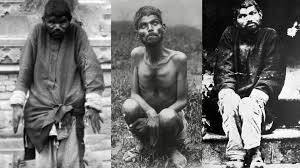
Dina Sanichar, a feral boy discovered in the mid-19th century, captivated the world with his extraordinary story. Found in the forests of Bulandshahr, India, in 1867, Dina had reportedly spent several years living among wolves. His uncanny ability to imitate their behavior and distinct lack of human socialization piqued the interest of both scientists and the public.
Raised in the wilderness, Dina’s early life closely resembled that of Mowgli, the beloved character from Rudyard Kipling’s “The Jungle Book.” Dina’s tale, much like Mowgli’s, highlighted the potential for human adaptability in the face of extreme circumstances. The discovery of this feral boy fueled debates about the boundaries between human and animal behavior.
Upon rescue, Dina faced significant challenges adjusting to human society. His communication skills were limited, and he struggled with basic social interactions. Efforts were made to reintegrate him into human life, shedding light on the delicate process of rehabilitating individuals who have experienced extreme isolation.
Dina’s story also sparked scientific curiosity about the critical period for human social development. Researchers drew parallels between his experiences and studies on critical periods for language acquisition and socialization, contributing valuable insights to the fields of psychology and anthropology.
While the true details of Dina Sanichar’s life remain shrouded in mystery, his legacy endures as a testament to the resilience of the human spirit and the intriguing intersections between the wild and civilized worlds. The parallels between Dina and Mowgli not only captivate the imagination but also serve as a reminder of the complex interplay between nature and nurture in shaping human behavior.
As Dina Sanichar gradually adapted to human society, his story became a focal point for explorations into the nuances of cultural identity and belonging. Raised without exposure to societal norms, Dina faced challenges comprehending the intricacies of human relationships and societal structures. His journey emphasized the importance of nurture in shaping one’s understanding of community and shared values.
Dina’s integration into human life also prompted discussions on the potential impact of early childhood experiences on cognitive development. Psychologists and anthropologists examined how his formative years in the wild influenced his cognitive abilities, shedding light on the malleability of the human mind and the adaptive mechanisms employed by individuals facing extreme circumstances.
The story of Dina Sanichar unfolded during a time of increasing interest in exoticism and fascination with the unknown. His presence in society fueled debates about the boundaries between the civilized and the untamed, reflecting the broader cultural and intellectual currents of the era.
Despite the challenges he faced, Dina’s story held a certain allure that extended beyond scientific inquiry. The public’s fascination with his journey inspired literary works, theatrical productions, and further adaptations of the Mowgli narrative. The enduring legacy of Dina Sanichar underscores the timeless fascination with tales of humans navigating the wilderness and the enduring quest to understand the essence of what it means to be truly wild or civilized.
Leave a Reply